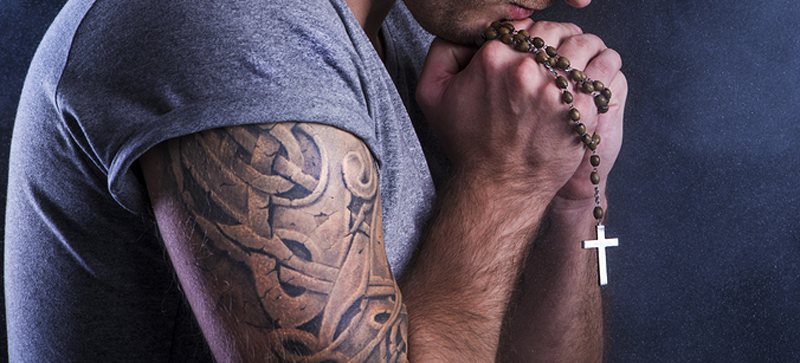
When Ray Bradbury published “The Illustrated Man” in 1951, tattoos covering virtually whole bodies were not as commonplace as they are today. Bradbury’s science fiction collection used as its starter a character whose body had been tattooed by a mysterious Minnesota crone. He became an object of wonder and terror as the tattoos came to life and unfolded bizarre stories.
In Bradbury’s day, tattoos were usually sported by sailors, war veterans, carnival workers, and the occasional hard laborer or trucker. Women weren’t tattooed unless they were Nazi concentration camp survivors or, possibly, part of a sideshow with a traveling troupe.
That having been said, we find ourselves in a very different day. Body art has been in style for some time, and we see it in abundance at the checkout line in the supermarket or on college campuses. Some online resources (such as one identifying itself as “The Catholic Gentleman” or another called “Tradition in Action”) raise questions about the morality of tattoos. Are they a form of self-mutilation? Do they violate Mosaic Law and align us with the prophets of Baal who leaped around cutting themselves amidst a contest with Elijah? Does getting permanently inked with skin graffiti violate the temple of the Holy Spirit?
There are no stock answers. Like many things, the intention of the person presenting himself or herself for tattooing is key.
From 2013 on there have been stories about religious sisters in Egypt having tattoos of crosses inscribed on their skin. They faced life-threatening persecution and wanted to show, even if they were arrested and stripped down, that their commitment to Christ was indelible.
At our most recent diocesan “Renew and Rejoice” retreat for youth ministers and DREs (directors of religious education), I met a young woman with a small tattoo of the Sacred Heart on one wrist and one of the Immaculate Heart of Mary on the other. She said that these are constant reminders to her of the love of Christ and his Blessed Mother. As we know, First Friday and First Saturday devotions have focused on the hearts of Jesus and Mary and the action of God’s mercy and sacrificial love.
The youth minister’s witness has led me to wonder if, indeed, tattoos can be sacramentals. We understand sacramentals to include sacred signs that help us realize the fruits of our Christian life and sanctify even our most ordinary moments and activities. I have a crucifix, a large painting of Saints Cyril and Methodius evangelizing, and an image of Our Lady of Guadalupe in my office. I wear a crucifix and a ring, and I carry a rosary. Most of these have been blessed. All are daily reminders of my commitments to Christ, Church, and religious community.
As debate about the merits or demerits of tattoos goes on, it seems that at least some tattoos can be signs of faith and devotion. They certainly won’t come to life, but they may serve as Godly life-signs — and counter-signs to a self-preoccupied culture.
Sister Pamela Smith, SSCM, is the Secretary for Education and Faith Formation at the Diocese of Charleston. Email her at psmith@catholic-doc.org.




